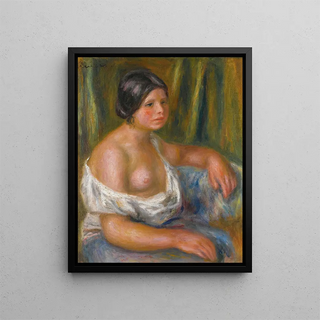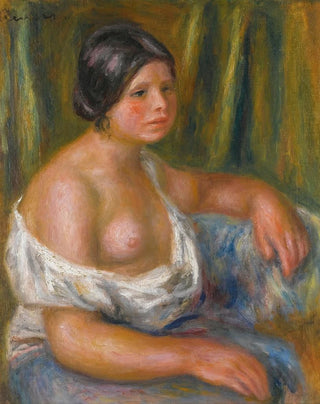Art print | Woman in Blue - Pierre-Auguste Renoir Source: Reproduction | Femme en bleu - Pierre-Auguste Renoir


View from behind

Frame (optional)
Femme en bleu - Pierre-Auguste Renoir – Captivating Introduction
In the fascinating world of impressionist art, the artwork "Femme en bleu" by Pierre-Auguste Renoir stands out for its elegance and sensitivity. Painted in 1876, this canvas depicts a woman dressed in a blue dress, capturing both light and movement. Renoir, with his unparalleled talent for representing human figures, invites us to immerse ourselves in a moment of grace and beauty. The delicacy of the composition and the vibrancy of the colors create an almost tangible atmosphere, where one can feel the softness of a sunny day. This piece, emblematic of its era, bears witness to Renoir's artistic genius and his ability to immortalize fleeting moments of life.
Style and uniqueness of the artwork
The strength of "Femme en bleu" lies in how Renoir plays with light and shadows, bringing his model to life. The blue dress, both simple and refined, is highlighted by touches of light that seem to dance across the fabric. The color palette chosen by the artist evokes a delicate harmony, where shades of blue blend with warmer tones, creating a striking contrast. The woman's posture, slightly turned toward the viewer, adds an intimate dimension to the scene, as if she is aware of our gaze. Renoir, true to his style, avoids overly rigid contours, favoring fluid and organic shapes that breathe life. This approach, characteristic of his work, makes "Femme en bleu" a perfect example of impressionism, where perception and emotion take precedence over realistic representation.
The artist and his influence
Pierre-Auguste Renoir, an iconic figure of impressionism, managed, throughout his career, to capture the beauty of the world around him. Born in 1841, he was influenced by masters such as Monet and Degas, but developed a style unique to him, focused on light and color. Renoir did not merely reproduce reality; he sought to express feelings, to evoke sensations. His innovative approach paved the way for

Matte finish

View from behind

Frame (optional)
Femme en bleu - Pierre-Auguste Renoir – Captivating Introduction
In the fascinating world of impressionist art, the artwork "Femme en bleu" by Pierre-Auguste Renoir stands out for its elegance and sensitivity. Painted in 1876, this canvas depicts a woman dressed in a blue dress, capturing both light and movement. Renoir, with his unparalleled talent for representing human figures, invites us to immerse ourselves in a moment of grace and beauty. The delicacy of the composition and the vibrancy of the colors create an almost tangible atmosphere, where one can feel the softness of a sunny day. This piece, emblematic of its era, bears witness to Renoir's artistic genius and his ability to immortalize fleeting moments of life.
Style and uniqueness of the artwork
The strength of "Femme en bleu" lies in how Renoir plays with light and shadows, bringing his model to life. The blue dress, both simple and refined, is highlighted by touches of light that seem to dance across the fabric. The color palette chosen by the artist evokes a delicate harmony, where shades of blue blend with warmer tones, creating a striking contrast. The woman's posture, slightly turned toward the viewer, adds an intimate dimension to the scene, as if she is aware of our gaze. Renoir, true to his style, avoids overly rigid contours, favoring fluid and organic shapes that breathe life. This approach, characteristic of his work, makes "Femme en bleu" a perfect example of impressionism, where perception and emotion take precedence over realistic representation.
The artist and his influence
Pierre-Auguste Renoir, an iconic figure of impressionism, managed, throughout his career, to capture the beauty of the world around him. Born in 1841, he was influenced by masters such as Monet and Degas, but developed a style unique to him, focused on light and color. Renoir did not merely reproduce reality; he sought to express feelings, to evoke sensations. His innovative approach paved the way for






